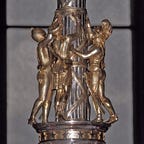Jan Steen — The Storytelling Painter
Jane Ottaway
I have always loved looking at paintings and I particularly like those which have stories to tell, faces of character and details which reveal themselves the more that the painting is viewed. Jan Steen was a Dutch artist which specialised in painting the scenes of everyday life with a moral message to them. He was a prolific painter who, it is believed, painted around eight hundred paintings. Unfortunately many were lost in the chaos and destruction of the World Wars, but the existence of around half of them is known with many major collections and art galleries having a selection of them.
I first came across his work Jan Steen when I visited the National Gallery of Scotland and saw the painting A School for Boys and Girls. As a secondary school teacher at the time, I was amused by the painting, the detail and the disarray. I could see the faces of the students painted at around 1670 and relate them to the pupils who were in my classes. In many ways little has changed in the character of children.
The symbolism also resonated with me. There are a few studious students working with the female teacher, those who had fallen asleep at their desks, those who were gossiping, others messing around, others trying to grab the teacher’s attention in the wrong way. The painting represented a microcosm of a school.
I bought a postcard of the painting which was always on the wall in my classroom. If ever a class was challenging or the lesson was not going as planned I would look at the painting and smile to myself, knowing that my lesson could never be a bad as Steen’s depiction (or so I hoped!).
I resolved to find out more about Jan Steen and his detailed, humourous scenes. Steen was born at Leiden c. 1626 to a father who was a brewer and the eldest of at least eight children. Growing up in the world of pubs and taverns must have given Steen great opportunities to observe characters. He was also an educated man having studied at the University of Leiden in 1646 and where he mainly worked, with periods in Haarlem, Utrecht and The Hague.
This education was utilised in his paintings which often had literary or historical references. For example, in ‘A School for Boys and Girls’, the owl represents the goddess Athena, a symbol of wisdom. A boy offers the owl a pair of spectacles referencing the Dutch proverb ‘What use are glasses or light if the owl does not want to see?’ Could Steen be referring to the poor quality of teaching or the disinterest of the pupils?
It is also believed that ‘A Schools for Boys and Girls’ is based on Raphael’s fresco of ‘The School of Athens’ in the Vatican which shows the great scholars of antiquity including Aristotle, Pythagoras, Plato and Archimedes.
Steen’s family were Catholic and he remained so himself which was also reflected in the religious paintings which he produced.
Steen often painted several paintings on the same them. ‘The School for Boys and Girls’ was on of a number of paintings on the school genre. ‘A School Class’ was painted in Leiden in 1672 showed a similar class here with a sleeping schoolmaster was sold by Sotheby’s Amsterdam in May, 2011.
It is one of only a few pictures by Steen to be both signed and dated. The children are taking advantage of the sleeping schoolmaster, who is so sound asleep that he is oblivious to the antics of his pupils.
Another example is ‘The Village School’ c. 1665 displayed by the National Gallery of Ireland, Dublin, Ireland. Here the teacher is awake and disciplining a child with Steen using his own three children, Catherina, Cornelis and Johannes as three of the models.
The 1st Duke of Wellington also appreciated Steen’s work and purchased his paintings at auction. There are four painting on display at Apsley House — ‘The Physician’s Visit’,’ The Dissolute Household’, ‘The Wedding Party’ and ‘The Egg Dance’. In each of these paintings there are similar qualities, humour and engagement to the school paintings. It can be argued that as the First Duke bought these paintings himself that they represented his personal taste. However, as Steen is said to epitomise the Dutch Golden Age of Art, the purchase of these paintings reflected a trend in Georgian England to own works of this time period.
As an example in ‘A Wedding Party’, the newly married couple are almost hidden from the viewer. Instead, Steen concentrates on the guests and their antics, just as in the school paintings the children grabbed the attention, here it is the turn of the adults. It is a woman with a saucepan on her head and a ladle in her hand who draws the eye from the bride and groom. She in turn is engaging with the seated woman who reaches out to her to stop her from intruding in the game of handjeklap which is one of the focusses of the painting.
It is here that Steen can draw on his experiences of the hostelry trade and incorporates himself at the drunk guest in the foreground, engaging with the viewer. He is easily identifiable from his self-portraits and frequently incorporated himself in his paintings.
Steen died on the 3rd February 1679 in Leiden in his native town which he had returned to from Haarlem in 1670 after the death of his father.
It is almost as if Jan Steen as the Storytelling Painter wants us to be drawn into his work to see the humour that he has devised in the paintings. His direct eye contact with the viewer centuries after the paintings were originally created enables this engagement. It shows us that much of what we find amusing today is the same as it was then.
